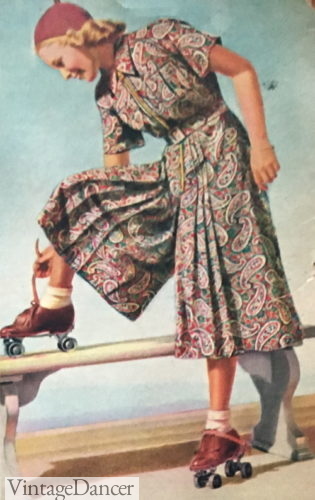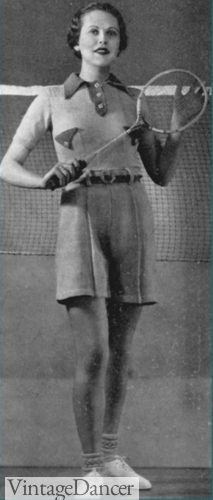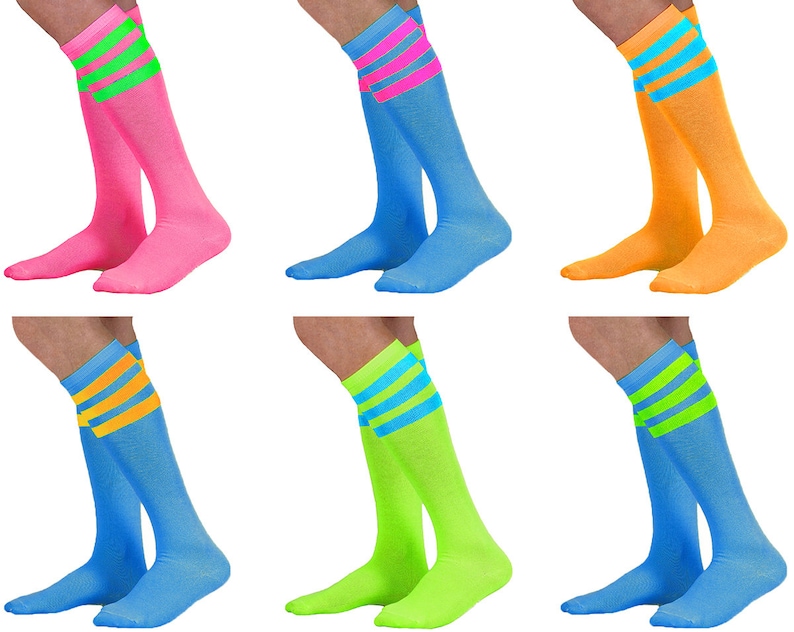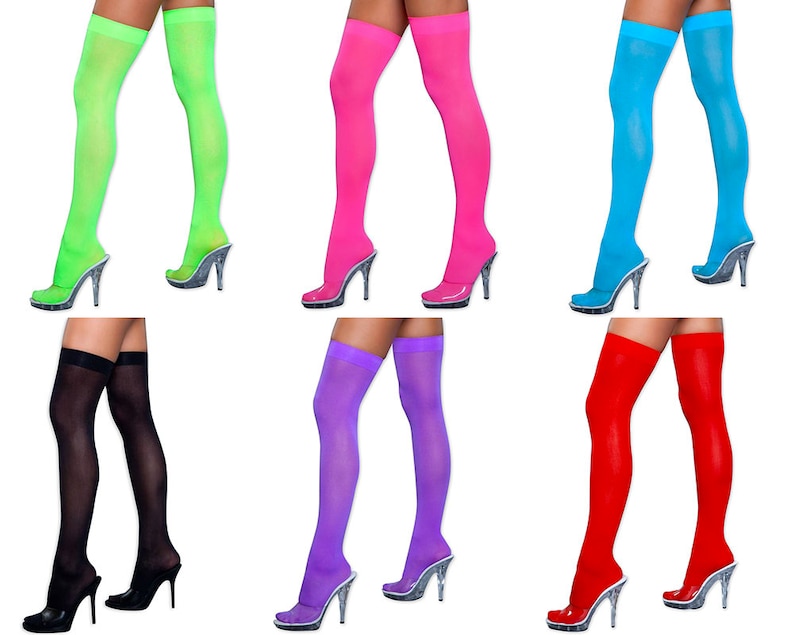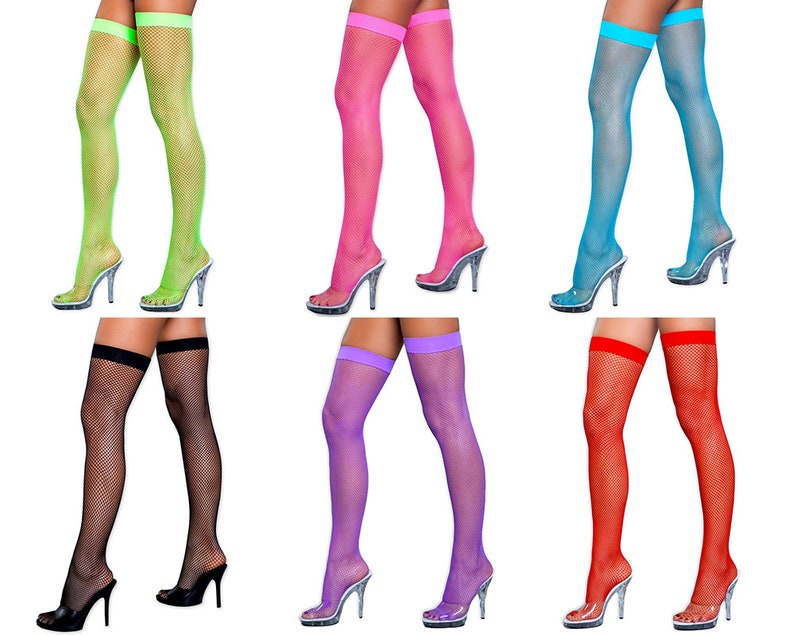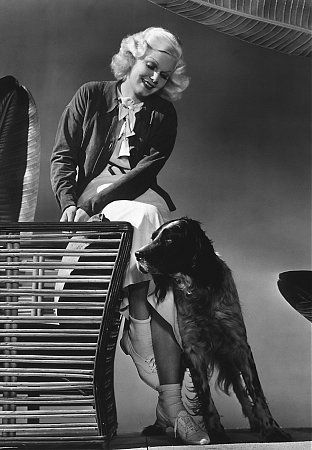
Jean Harlow models her sporting attire, complete with ankle socks in the 1930s.
Socks are often overlooked or disregarded as items of little importance. Indeed, socks are hardly perceived as garments of glamour. Despite this, however unimportant they appear, attitudes towards socks have shifted throughout the twentieth century. In particular, attitudes towards the wearing of socks by women.
In order to investigate the history of vintage women’s socks, we must first explore the development and adaptation of leisurewear follow by the influence of the teenager, the original bobbysoxer.
For men’s vintage socks history read here.
Women’s Vintage Socks – Early Beginnings
During the First World War, women adopted a more practical mode of dressing. Women found themselves outside of the home in new roles. Functional, practical clothing was suddenly an important factor to consider when selecting appropriate attire. As WWI caused a shift in the function of women’s clothing, this development continued and progressed throughout the twentieth century. Prior to this period, women’s daily attire was mostly chosen on aesthetic qualities, with little consideration for mobility of movement.
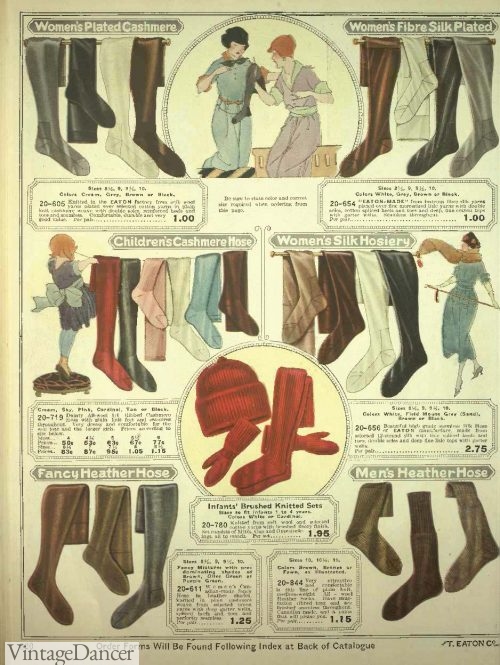
A selection of women’s hosiery and stockings from the early 1920s.
As WWI caused women’s clothing to become more practical, this in turn facilitated the development of sportswear for women. From the mid nineteenth century, sporting activities and leisurely pastimes became fashionable. Tennis, croquet, and cycling were all viewed as appropriately tasteful activities for ladies to partake in.
Wearing silk stockings for sporting activities was not practical. Cotton and wool over the knee ribbed stockings were better, more durable choices.
1920s Vintage Women’s Socks
The Victorian fascination with exercise and sports continued into the next century. Physical education was offered by schools and colleges for women from the late 1800s. Individual schools and colleges would have their own kits of sporting attire for their students to wear.
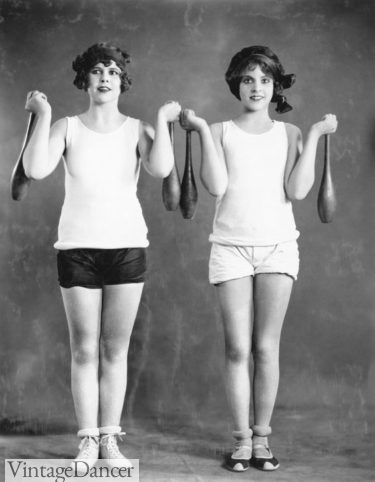
Stocking rolls down to the ankles
By the 1920s, the gym suit had developed into a blouse style top, with elasticated bloomers beneath a skirt. Socks were worn with the gym suit, but at first they were often worn over the top of stockings. It was seen as shocking for women to bare their legs during this time.
To illustrate this, stockings were available in ‘nude’ tones by the mid 1920s. While a daring few dressed their legs in this new flesh shade, many viewed the ‘nude’ tone stockings as scandalous.
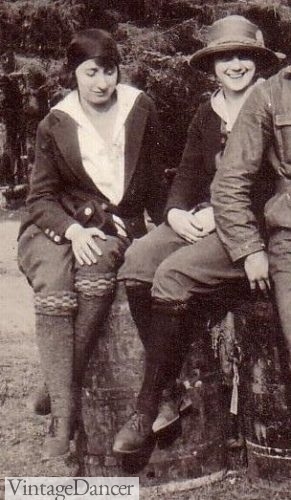
1920s sport socks worn with breeches
For sporting activities during this time, women wore knee high socks or hose. These were worn rolled back just an inch or two below the knee. Commonly, these would be fashioned in wool yarns, particularly for outdoor activities during colder months.
These cuffed sport socks were the first, true socks for women.
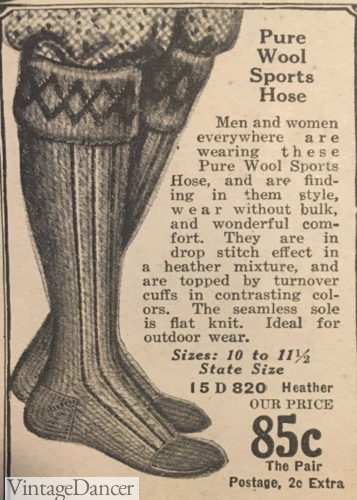
1925 men and women’s sport socks with cuff top
1920s Spatter Dashers
In addition to women wearing stockings and sports hose, another type of hosiery emerged. Spatter dashers, or just spats, were previously worn by men in order to protect their shoes and pants, usually fashioned from practical materials such as leather or wool. However in the 1920s, women adopted these and wore them as a fashion accessory.
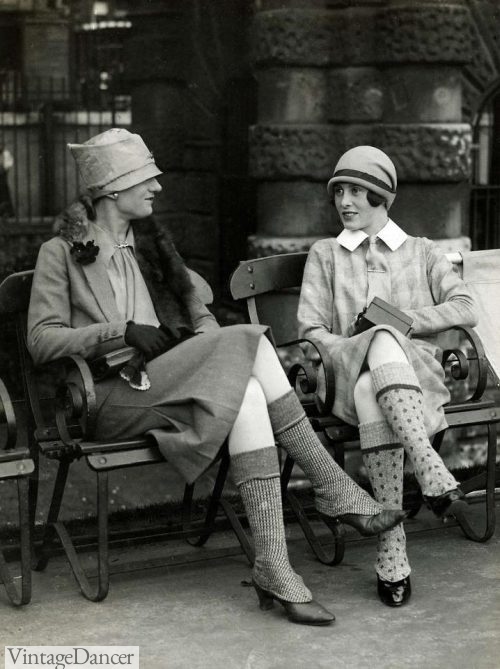
This picture illustrates how spatter dashers would have been worn in the 1920s. The bold patterns create a fashion statement, whilst the woollen yarn facilitates in keeping these ladies warm.
Women’s spatter dashers could be worn rolled down, to sit just below the knee, or over the knee. They would commonly be worn over stockings, and be made of jersey or wool fabrics, featuring decorative details such as patterns or buttons. The whole point of spatter dashers was to make a fashion statement – and indeed it helped that they were actually warm to wear, too.
1930s Women’s Socks
One solution in the late 20s and early 30s to the bare legs dilemma was the wearing of both stockings and socks combined. However, this of course would be uncomfortable, not to mention highly impractical for sporting activities.
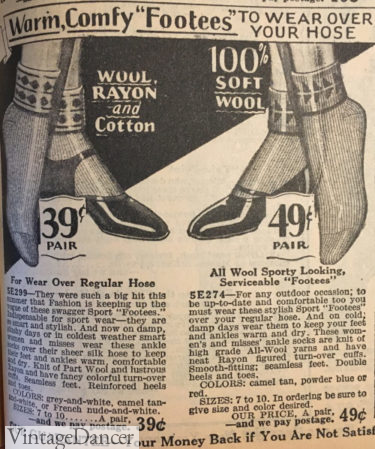
1929 ankle socks worn over stockings
An ingenious solution was to design hosiery and socks as one garment, as illustrated below.
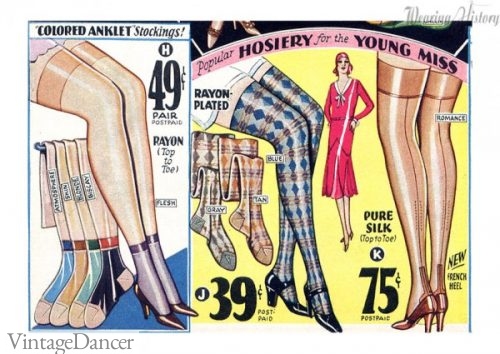
This illustration from the early 1930s shows bold patterned hosiery. In addition, notice the stockings and anklets combined.
As surprising as this may sound, it was not until the early 1930s that women finally wore ankle socks without the addition of stockings.
During the 1930s, it became fashionable to possess tanned skin. Sun bathing was popular, as were holidays in sunny climes. In addition to this, sports, fitness and physical activities were all popular pastimes. This craze for sun-kissed skin allowed women to expose flesh in the quest for the all important tan.
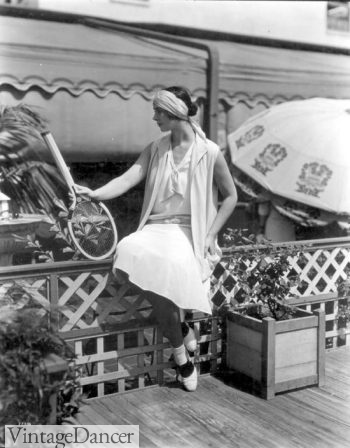
1929, short socks were worn for sporting attire instead of stockings
Tennis grew in popularity, with playsuits, rompers, and sports dresses all designed specifically to be worn. Ankle socks were often worn, as they simultaneously protected the feet from friction whilst also enabling the legs to be bare and cool.
- 1938 roller skating in socks and playsuit
- 1935 tennis outfit with socks
As ankle socks gained popularity, they became available in a host of colors. Pastels shades were a popular choice, perfectly complementing a golden tan.
By this time, we can see from the advertisement below that ankle socks were referred to as anklets. In order to facilitate the socks staying in place, the cuffs of the socks would feature lastex – an early elastic yarn.
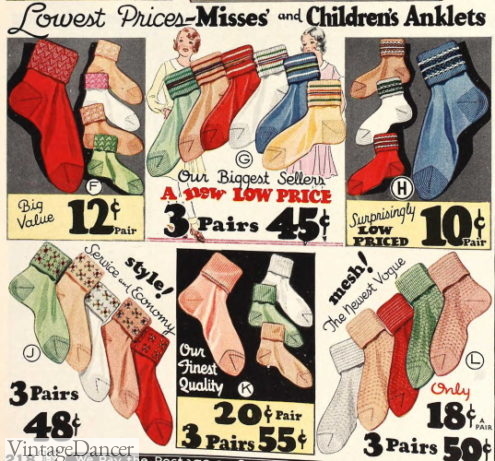
1932 socks for women and children
By the 1930s, a host of yarns and materials were used in the production of socks. Natural fibers such as cotton, silks and wools were all popular. In addition, man-made fibers such as rayon were a popular alternative to more costly options.
By this time, as we have discussed, women wore ankle socks and exposed more skin than previous decades. However, this attire was still only appropriate while participating in sporting activities or when on holiday. Women still had a little way to go before bare legs and ankle socks would be deemed as acceptable daywear.
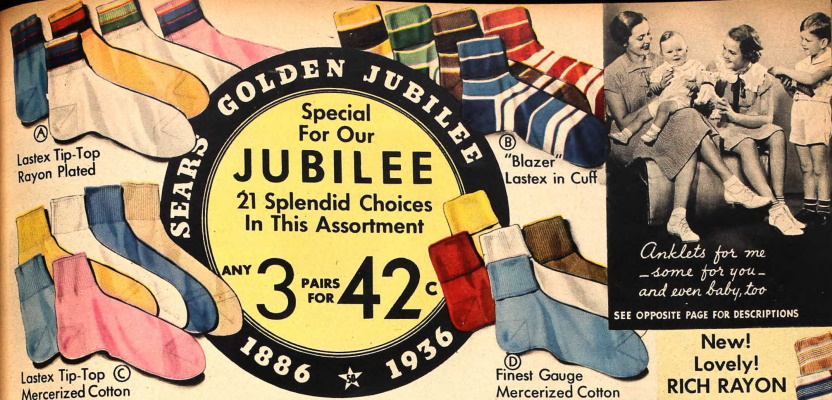
1936 basic socks for the entire family
1940s Vintage Women’s Socks
As the 1930s came to a close, WWII was declared. The implications of WWII were far and wide, reaching even into the infrastructure of clothing and fashion. By this time, women would generally wear stockings with their daily attire. However, as stockings became scarce and the rationing scheme was implemented in the UK, hosiery became more difficult to obtain. Under the UK rationing scheme, a single pair of stockings could cost 3 coupons – an extravagance too far for many.
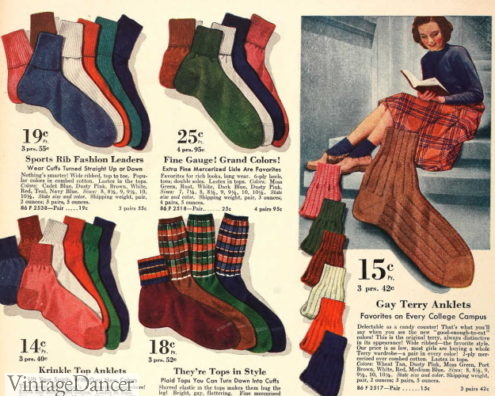
1940 ankle socks
In light of this, women started to experiment with ‘leg make up.’ While the UK government developed stockings under the Utility scheme, many were of poor quality and not worth the outlay. In addition to leg make up, women adopted a new leg covering – pants. Practical and warm, pants were the perfect choice for many of the new roles women now found themselves in. Of course, the perfect pairing with pants was ankle socks.
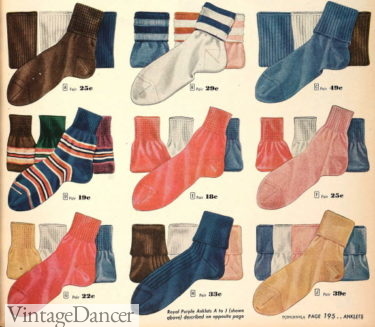
1947 socks for women and children
Once again, as women’s roles shifted, a more practical approach to fashion was required. During this time, it was finally acceptable for women to wear ankle socks teamed with pants. Working Rosies wore socks doing factory and farming. Even the iconic Rosie the Riveter illustration features red socks.
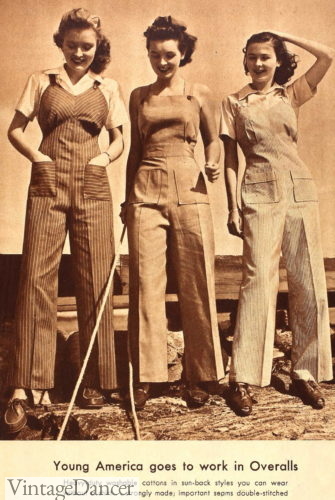
Wearing socks with overalls
When silk and nylon were needed for the war effort, many women only wore socks during the day, saving what few pairs of stockings they did own for use in the evenings. Socks were usually not worn with heels, only loafers and Oxfords.
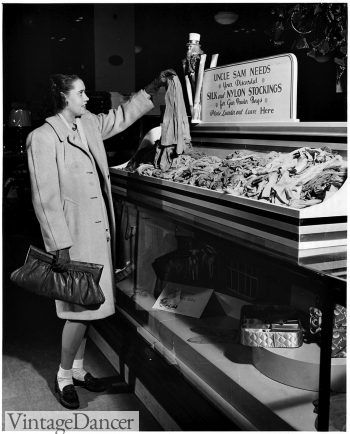
1942 woman donating her silk stockings and wearing socks instead.
In addition to wearing anklets for sports or ankle socks with pants, women also wore knee high socks with skirts. As previously discussed, stockings were difficult to obtain, so knee high socks were seen as a convenient alternative. These would be worn just below the knee, usually with the cuff folded back. Many socks were home knitted during this time, with wool yarns being a popular choice.
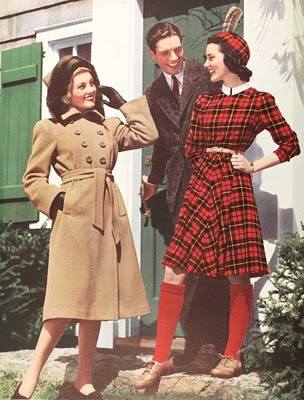
1940s knee high socks worn with flat shoes.

1946 school girl outfit
Vintage Socks for Teenagers
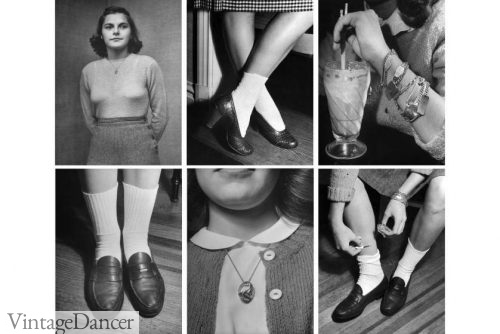
1944 teenagers wore socks pulled up, using a bit of nail polish to hold them in place.
We have seen that by the 1940s, it was finally acceptable for women to wear ankle socks as part of their daily attire. However, one section of society had been wearing ankle socks free from social consequence for a while prior to this. As sportswomen adopted ankle socks and bare legs in the early 1930s, young women – teenagers – also followed suit. As children, they were already used to wearing socks. Stockings were too grown up for them.
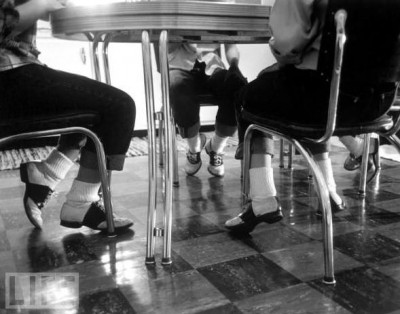
Teens wearing saddle shoes and bobby socks in 1949.
From the late 1930s, young women would wear ankle socks with their loafers or saddle shoes. While the phrase ‘teenager’ may not have become popular until the 1950s, this social group was certainly identified from the 1930s onwards.
Throughout the 1940s and into the 1950s, young women wore colorful bobby socks with their flat shoes. Pink, yellow, red, baby blue, and teal to name just a few. Some sporty versions had white stripes as well. The term bobby socks emerged in the early 1940s, however we often think of it to describe the attire of a 1950s teen. The 1950s teenager almost always wore new, perfectly clean, white socks. This short film from Glamourdaze shows a line-up of college girls proudly showing off their ankle socks in 1944.
Throughout the 1950s, young adults and teens commonly wore their ankle socks with the cuffs rolled back. This created a bulky look at the ankle and generated a relaxed, carefree style.
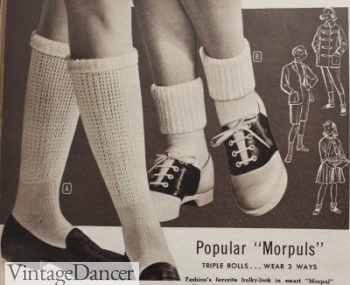
1957 White socks in knee high and thick “tipple roll” styles
By this time, ankle socks almost became synonymous with youth, teenagers, and the formative years of education. Various fads and trends were incorporated into ankle socks. Bold colors, loud patterns, and even the way in which they worn – pulled up, rolled down – all denoted an element of individuality.
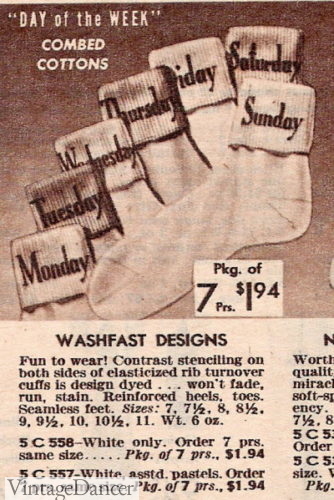 The illustration above even demonstrates anklets with the days of the week incorporated onto the cuffs – a wonderful example of novelty designs of this era. Other popular designs were of music notes and animals (pink poodles!).
The illustration above even demonstrates anklets with the days of the week incorporated onto the cuffs – a wonderful example of novelty designs of this era. Other popular designs were of music notes and animals (pink poodles!).
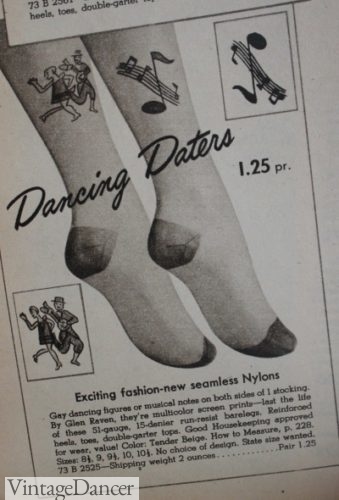
In addition to anklets and ankle socks, knee high socks were also a popular choice among young women. They were colorful and textured, with chunky knit weaves popular in winter and argyle prints paired with shorts in summer.
Shop 1950s style bobby socks and knee highs.
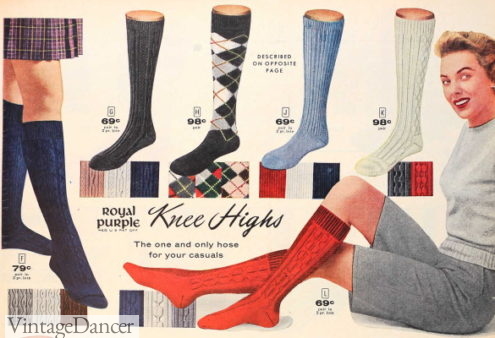
1955 tall calf socks- cable knits, argyle, ribbed knit
1960s Vintage Socks
Throughout the late 1950s and into the 1960s, knee high socks were a popular alternative to stockings. Both tights and over the knee high socks were seen as a fresh, exciting alternative to stockings or short ankle socks. They each came in more vivid colors, wild patterns, and lace effect textures.
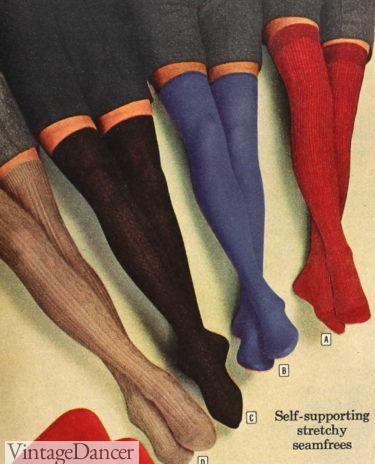
1959 knee high socks
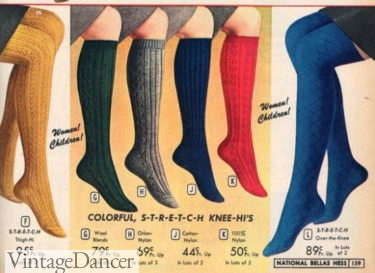
1964 knee high socks
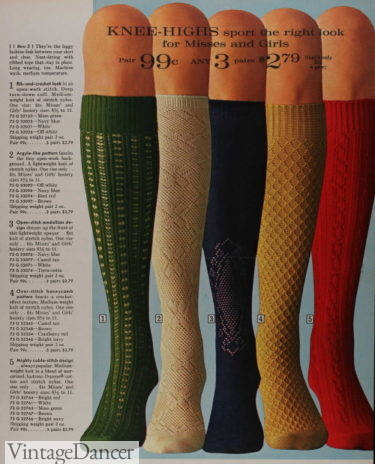
1969 knee high lace effect socks
Also during this time, new man made fibers were developed, such as polyester and spandex. These new fibers with their improved elasticity resulted in better fitting socks, knee highs, and indeed tights.
1970s -1980s Socks
Knee high socks continued throughout the 1970s. They came in unique novelty patterns or plain colors to match outfits.
As the decade neared the 1980s, women’s sock designers turned to young girls socks for some inspiration. Suddenly white and pastel ankle socks were back in style with the new softer romantic dress looks. Some were trimmed with lace to make them even younger.
Cyndi Lauper and Madonna both wore ruffle ankle socks in their music video’s propelling the trend even further.
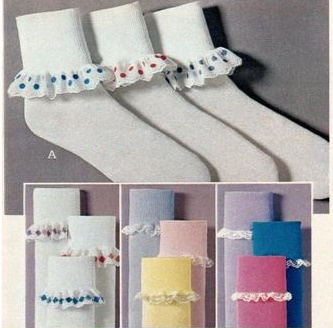
1984 ribbon and lace trim socks
In the 1980s the lace effect was applied to the knitting pattern of socks.
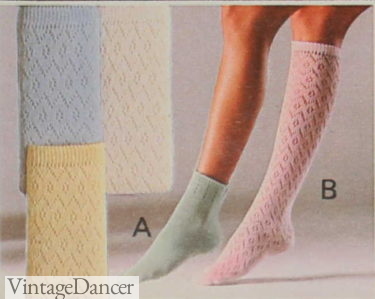
1984 lace effect knit socks
The 1980s saw women and girls layering 2 or more pairs of colored sucks. Instead do folding down a cuff, they now pushed down socks to create a scrunch effect. Special 80s scrunch socks or slouch socks were made to make the took like leg warmers.
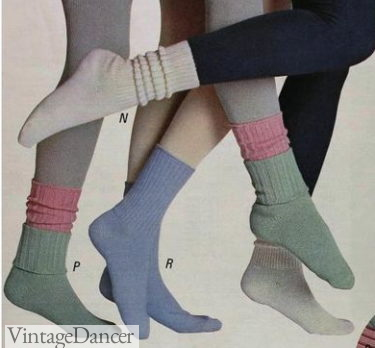
1988 double layer fold or scrunch socks
Today, ankle socks retain their aura of youth. Certainly when worn with bare legs, they convey a mood of innocence that gossamer fine stockings with their womanly connotations could not. Whether worn to recreate a 1930s sporting look, or a 1940s utility outfit, or 1960s youthquake fashion, vintage socks still have a very valid place in the wardrobe of today’s vintage loving connoisseur.
New Vintage Style Socks
New socks still come in many vintage styles- both knee high and ankle socks in the colors, patterns, and textures during the 20th century. Shop them here:
